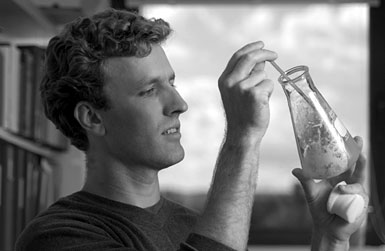DMS geneticists shed light on photoreception
A team of DMS geneticists has found a molecular shortcut from light-reception to gene-activation in their ongoing research into biological clocks. Their work has revealed that a protein called White Collar-1 (WC-1) does double duty: it perceives light and then, in response to light, it turns on a key gene called frequency, a central component of the cellular clock that paces life's daily ebb and flow.
Biological clocks are set by the daily cycles of light and dark. Using the fungus Neurospora— common bread mold—the Dartmouth team is studying how organisms keep track of time using this internal clock.
"What we have discovered is that a protein called White Collar- 1 is both the photoreceptor and the mechanism that turns on the frequency gene, all in one molecule," says Allan Froehlich, a graduate student who was the lead author of the article reporting the new work. "It's the combination of the two activities that is so interesting."
Genetic underpinnings: The finding, which was published in the journal Science, was also the work of Jay Dunlap, Ph.D., a professor and the chair of genetics; Jennifer Loros, Ph.D., a professor of biochemistry; and postdoctoral fellow Yi Liu, Ph.D., now on the faculty at the University of Texas Southwestern Medical Center. Dunlap and Loros have made numerous contributions to understanding biological clocks' genetic underpinnings.
Researchers working with a variety of organisms had already begun to understand how photoreceptor proteins perceive light at the molecular level and then pass on this information through a series of other proteins. This new finding about WC-1 reveals a relatively simple step that takes place between a protein perceiving light and activating a gene.

|
|
DMS graduate student Allan Froehlich,
below, was the lead author on a study
that identified a significant new mechanism
in the cellular biological clock. |
"Virtually nothing is known about how pathogenic fungi respond to light or whether our discovery can be exploited for a noninvasive medical therapy," Dunlap says. "But, if you want to do therapy—antifungal, antibacterial, or anything—you start looking for biochemical activities that the host does not have that can be targeted to the pathogen."
Froehlich, working with Dunlap and Loros, built on their discovery that the gene frequency encodes a central cog of the biological clock cycle and that light resets the clock through frequency. He then determined that WC-1 and WC-2 bind to the specific parts of frequency that turn it on in response to light. Finally, he showed that under appropriate biochemical conditions, WC-1 is the photoreceptor protein.
Lots more to discover: "The next step is to continue to understand how the proteins work," Froehlich explains. "There are many more unidentified proteins that may be influencing biological clocks, which provides us with lots more to discover."
Sue Knapp
